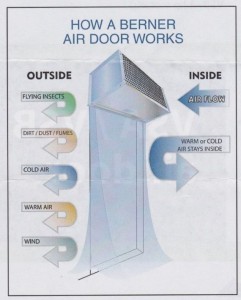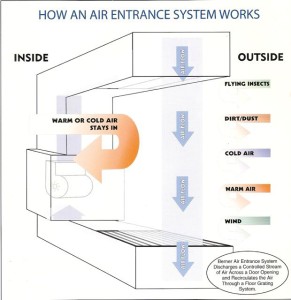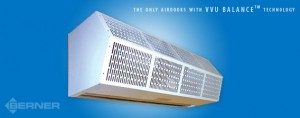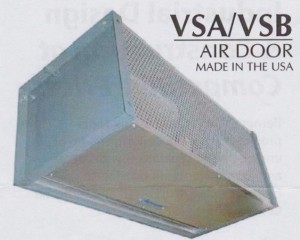The free, unobstructed flow of traffic is an important factor in planning access to your facility. Berner International, is a pioneer in the development and manufacture of air curtains, offers an aesthetically pleasing solution for high traffic entrance ways – The Berner Air Entrance System. This innovative entrance system provides a recirculated air seal, through concealed ductwork, effectively creating a barrier between indoor and outdoor temperature conditions. Open access, safety, and energy efficiency are created out of thin air with the Berner Air Entrance System – the only air entrance system backed by the engineering expertise of Berner International.
Tag Archives: air door
Berner International Air Entrance System
Berner Air Curtains: A Viable Alternative to Vestibules
Berner Air Curtains: An Alternative to Vestibules
Not all buildings have room for vestibules. Not all owners want a vestibule, and there are spaces where a vestibule is just not practical or takes away from the design intent.
As part of our response to the Design and Construction Community asking for information and data to support using an air curtain in place of or along with a vestibule, we did two things:
- We researched air curtain (a.k.a. “air door”) effectiveness via both CFD modeling and physical testing,
- We went to AMCA (Air Movement & Control Association) and asked AMCA to do its own research on air curtain effectiveness on behalf of all the air curtain manufacturers.
Here is the Berner infographic summarizing the results. Please click on the link below to view the full size PDF version.
Berner_International_Blown_Away_InfoGraphic
Not Sure Which Berner Door You Need?
 Not sure which of Berner’s Air Doors will fit the application you have? Use Berner’s Site Application Survey. Answer the questions and let the experts at Berner Air Door help you to the right solution.
Not sure which of Berner’s Air Doors will fit the application you have? Use Berner’s Site Application Survey. Answer the questions and let the experts at Berner Air Door help you to the right solution.
Three Basic Door Switches – Berner Air Curtains
Three common types of door switches used to turn on & off a Berner Air Curtain.
Berner Air Doors / Air Curtains
What is an Air Curtain / Air Door?
Berner Air Curtains / Air Doors
An air door, also called an air curtain, employs a controlled stream of air aimed across an opening to create an air seal. This seal separates different environments, while allowing a smooth, unhindered flow of traffic and unobstructed vision through the opening. Because air doors/air curtains help to contain heated or air conditioned air, they provide sizeable energy savings and personal comfort when applied in industrial or commercial settings. Air curtains can also be used to stop the infiltration of flying insects.
Berner VSA/VSB Air Door
Berner Air Doors, VSA/VSB Air Door
- FULLY ASSEMBLED UNIT No on-site assembly required
- EASY ACCESS TO WORKING COMPONENTS Removable top and bottom access covers
- MOUNTING LENGTHS UP TO 16 FEET WIDE Ideal for shipping and receiving doors
- QUICK RETURN ON INVESTMENT The average Berner air door pays for itself in less than two year.
Standard Features:
- Lengths from 36″ to 192″
- High efficiency, low noise Pro-V Nozzle (patent pending)
- Galvanized steel blower wheels and housing
- Airfoil aluminum air directional vanes
- Gray powder coated finish with mill aluminum inlet screen
- 16 gauge aluminum steel cabinet
- 1/2″ mounting holes (wall or top mounting)
- No field assembly required
- VSA – 1/2 hp motor(s)
- VSB – 1 hp motor(s)
- Unheated or hearted (electric, steam, hot water or indirect gas)
- 5 year parts warranty (unheated units), 2 year (heated units)
- Crafted with pride in the USA
RECOMMENDED PROTECTION HEIGHT
- Insect Control 10′
- Environmental Separation 12′
RECOMMENDED FOR OPENING TYPE
- Conveyor
- Cooler/Freezer Door
- Shopping Cart
- Service Door
- Shipping/Receiving
How a Berner Air Door Works
 Berner Air Doors provide a powerful uniform stream of air engineered to separate environments and to protect openings against: Flying Insects, Dust, Fumes and Airborne Contaminants.
Berner Air Doors provide a powerful uniform stream of air engineered to separate environments and to protect openings against: Flying Insects, Dust, Fumes and Airborne Contaminants.





